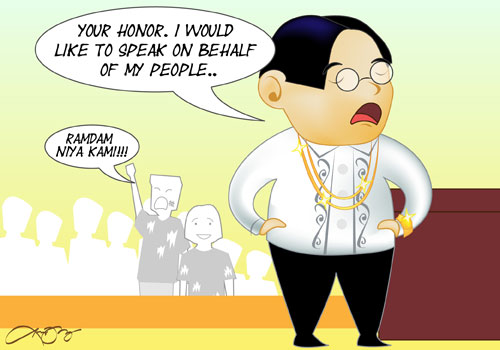Millionaire congressmen represent poor constituents
The House of Representatives is a millionaires' club, with its members possessing wealth vastly greater than that of most of the Filipinos they represent, according to data analyzed by GMA News Research. The 2010 Statement of Assets, Liabilities and Net Worth (SALN) of district representatives in the 15th Congress shows that the average net worth of a district representative is about 120 times bigger than the average Filipino family income. Ninety-eight percent, or 224 out of the 228 district representatives, are from high-income families. High-income families are those that earn about P2.4 million a year, or almost P200,000 a month. Figures in 2006 from the Philippine National Statistical Coordination Board show that only about 20,000 families, or 0.1 percent of families in the country, are classified as high-income families. Only four of the 228 district representatives did not make it to the high-income family category, but these representatives are also millionaires. Party-list representatives are not included because their constituency is national in scope. In contrast, about 80 percent of families in the Philippines are classified as low-income families, earning less than P28,000 a month. Based on the 2009 National Statistics Office (NSO) Family Income and Expenditure Survey, the national average annual family income in the country is P206,000. The average annual family income is the combined income received by a family of five. The NSO includes as sources of income wage and salaries, entrepreneurial activities, cash receipts from abroad and pension and retirement benefits.  Meanwhile, the 2010 SALN of district representatives shows that the average net worth of district representatives is P25,528,500. This shows that on average, the Filipino family's earning for a year is equivalent to only three days of income of a district representative. "We do not elect congressmen who represent who we are. [The rich congressmen] have very little understanding of how the average citizen lives," said political analyst and economist Dr. Milwida Guevara. Guevara said the rich congressmen who are put into office may not understand the lives of the ordinary Filipinos they represent, thus affecting the kinds of legislation they churn out. "How will they legislate a better system for the public schools? They don't understand the problems of the people," she said. "Walang chance for real representation." Richest congressmen, poorest provinces The richest congressman is Sarangani Rep. Manny Pacquiao, who also happens to be a world-renowned champion boxer. In 2010, his average net worth is over P1 billion. Meanwhile, Pacquiao's constituents belong to the 12th poorest country in the Philippines in 2009. Four in 10 families in Sarangani are considered poor, and the poverty incidence in the province increased from 34 percent in 2006 to 40.7 percent in 2009. The average annual family income in Sarangani is the fourth lowest among provinces. Pacquiao earns more than 10,533 times bigger than his constituents yearly. However, Pacquiao's case is more the exception than the rule because he was already a billionaire when he entered the political arena. Transparency and Accountability Network executive director Vincent Lazatin said people should examine more closely other district representatives who got rich while in office or after serving a term in office. Lazatin told GMA News Online that the wealth of legislators is an indication that political office in the country are for those who have money. "Or it could mean that those in political office make money, and that raises some concerns," he said. Apart from Pacquiao, the top 10 richest representatives come from the following provinces:
Meanwhile, the 2010 SALN of district representatives shows that the average net worth of district representatives is P25,528,500. This shows that on average, the Filipino family's earning for a year is equivalent to only three days of income of a district representative. "We do not elect congressmen who represent who we are. [The rich congressmen] have very little understanding of how the average citizen lives," said political analyst and economist Dr. Milwida Guevara. Guevara said the rich congressmen who are put into office may not understand the lives of the ordinary Filipinos they represent, thus affecting the kinds of legislation they churn out. "How will they legislate a better system for the public schools? They don't understand the problems of the people," she said. "Walang chance for real representation." Richest congressmen, poorest provinces The richest congressman is Sarangani Rep. Manny Pacquiao, who also happens to be a world-renowned champion boxer. In 2010, his average net worth is over P1 billion. Meanwhile, Pacquiao's constituents belong to the 12th poorest country in the Philippines in 2009. Four in 10 families in Sarangani are considered poor, and the poverty incidence in the province increased from 34 percent in 2006 to 40.7 percent in 2009. The average annual family income in Sarangani is the fourth lowest among provinces. Pacquiao earns more than 10,533 times bigger than his constituents yearly. However, Pacquiao's case is more the exception than the rule because he was already a billionaire when he entered the political arena. Transparency and Accountability Network executive director Vincent Lazatin said people should examine more closely other district representatives who got rich while in office or after serving a term in office. Lazatin told GMA News Online that the wealth of legislators is an indication that political office in the country are for those who have money. "Or it could mean that those in political office make money, and that raises some concerns," he said. Apart from Pacquiao, the top 10 richest representatives come from the following provinces:





